利用者:ロイヤルオーク/sandbox/下書き11
The United Nations Educational, Scientific and Cultural Organization (UNESCO) World Heritage Sites are places of importance to cultural or natural heritage as described in the UNESCO World Heritage Convention, established in 1972.[1] Greece ratified the convention on 17 July 1981, making its natural and cultural sites eligible for inclusion on the list.[2]
2021年現在[update], there are 18 properties in Greece inscribed on the World Heritage List, 16 of which are cultural sites and two (Meteora and Mount Athos) are mixed, listed for both their natural and cultural significance. The first site added to the list was the Temple of Apollo Epicurius at Bassae, in 1986. The next two sites listed were the Archeological site of Delphi and the Acropolis of Athens, in the following year. Five sites were added in 1988, two in 1989 and 1990 each, one in 1992, one in 1996, two in 1999, and one in 2007. The most recent site added was the Archaeological Site of Philippi, in 2016. There are no transnational sites in Greece. In addition, there are 14 sites on the tentative list, all of which were nominated in 2014.[2]
World Heritage Sites
[編集]UNESCO lists sites under ten criteria; each entry must meet at least one of the criteria. Criteria i through vi are cultural, whereas vii through x are natural.[3]
| Site | Image | Location (region) | Year listed | UNESCO data | Description |
|---|---|---|---|---|---|
| Temple of Apollo Epicurius at Bassae | 
|
Peloponnese | 1986 | 392; i, ii, iii (cultural) | The temple, dedicated to Apollo Epicurius, was built in the 5th century BCE in the mountains of Arcadia. It is considered by UNESCO to be one of the best preserved monuments of classical antiquity. It is the earliest monument that features all three classical orders, Doric, Ionic, and Corinthian. After falling out of use, the temple was forgotten for nearly 1700 years. It was rediscovered in the 18th century, attracting the attention of scholars and artists.[4] |
| Archeological site of Delphi | 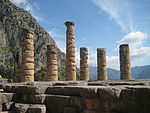
|
Central Greece | 1987 | 393; i, ii, iii, iv, vi (cultural) | Delphi, located at the foot of Mount Parnassus, was the site of the Temple of Apollo, a Panhellenic sanctuary, and in Greek view the "navel of the world" (the Omphalos). Pythia, the oracle, resided in the temple, receiving pilgrims from all Greece. In the 6th century BCE, Delphi was seen as the religious centre and symbol of unity of the ancient Greek world.[5] |
| Acropolis, Athens | 
|
Attica | 1987 | 404; i, ii, iii, iv, vi (cultural) | The Acropolis of Athens stands on a steep hill above the city. Originally a fortification, it gradually developed into a religious sanctuary, associated with the cult of the goddess Athena. In the 5th century BCE, following their victory over the Persians, the Athenians under Pericles constructed a large number of monuments including the Parthenon, the Erechtheion, the Propylaia, and the Temple of Athena Nike. The monuments in the Acropolis have prominently inspired the Neoclassical architecture.[6] |
| Mount Athos | 
|
Monastic Republic of Mount Athos | 1988 | 454; i, ii, iv, v, vi, vii (mixed) | Situated on a narrow peninsula, Mount Athos has been governed as an autonomous entity since Byzantine times. An Orthodox spiritual centre since the 10th century, it is home to about 20 active monasteries. Mount Athos has exerted lasting influence on the development of religious architecture and monumental painting.[7] |
| Meteora | 
|
Thessaly | 1988 | 455; i, ii, iv, v, vii (mixed) | Meteora is a rock formation of sandstone peaks, hosting 24 Orthodox monasteries. Many of them were built on the almost inaccessible peaks during the revival of the eremeric ideal in the 15th century. The monasteries are decorated by 16th century frescoes, which represent a key stage in the development of post-Byzantine painting.[8] |
| Paleochristian and Byzantine monuments of Thessaloniki | Central Macedonia | 1988 | 456; i, ii, iv (cultural) | Thessalonika was one of the first bases for the spread of Christianity. This site comprises several churches (including the Church of Hosios David and Hagios Demetrios (pictured)), constructed from the 4th to the 15th century, city walls from the early Byzantine period, and the Rotunda, commissioned in the 4th century by the Roman Empire Galerius and later converted into a church.[9] | |
| Sanctuary of Asklepios at Epidaurus | 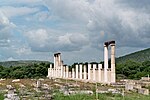
|
Peloponnese | 1988 | 491; i, ii, iii, iv, vi (cultural) | The cult of Asklepios, the god of medicine, developed in the city-state of Epidaurus at the latest in the 6th century BCE. The principal monuments at the site include the Temple of Asclepius, the Tholos, and the Theatre, which is considered to be the finest ancient Greek theatre. The sanctuary is important in the history of medicine, marking the transition from the belief in divine healing to the science of medicine.[10] |
| Medieval City of Rhodes | 
|
South Aegean | 1988 | 493; ii, iv, v (cultural) | The island of Rhodes was occupied by the Order of St John of Jerusalem (Knights Hospitaller) from 1309 to 1523, who transformed the city of Rhodes into a stronghold and surrounded it with a 4キロメートル (2.5 mi) wall. The fortifications were built upon the existing Byzantine ones. The Upper town features several buildings from the Gothic period, including the Palace of the Grand Masters, the Great Hospital, and the Street of the Knights. When the Ottomans took the island, they converted most churches to mosques. Reconstruction took place during the Italian occupation in the early 20th century.[11] |
| Archeological site of Mystras | 
|
Peloponnese | 1989 | 511; ii, iii, iv (cultural) | The town of Mystras developed around the fortress erected in 1249 under the Prince of Achaia, William of Villehardouin, on the slopes of Mount Taygetus. In 1262, it was surrendered to the Byzantines and saw a great prosperity during the Palaeologan Renaissance era. It was later taken first by the Ottomans and then by the Venetians. After 1834, the inhabitants started leaving Mystras for the modern town of Sparta, and Mytras became a ruin.[12] |
| Archeological site of Olympia | 
|
West Greece | 1989 | 517; i, ii, iii, iv, vi (cultural) | In the 10th century BCE, Olympia became a centre for the worship of Zeus. It was a Panhellenic sanctuary and the location of the ancient Olympic Games, beginning in 776 BCE. In addition to numerous temples and sanctuaries, it contains the remains of several sporting structures, such as its stadium.[13] |
| Delos | 
|
South Aegean | 1990 | 530; ii, iii, iv, vi (cultural) | The birthplace of Apollo and Artemis according to Greek mythology, the sacred island of Delos was one of the most important Panhellenic sanctuaries during the Archaic and Classical periods. The sanctuary of Apollo on Delos attracted pilgrims from all over Greece, making Delos a prosperous trading port. It fell into decline after 69 BCE.[14] |
| Monasteries of Daphni, Hosios Loukas and Nea Moni of Chios | 
|
Central Greece, Attica, North Aegean | 1990 | 537; i, iv (cultural) | These three monasteries, although located in different parts of Greece, are representative examples of the middle period of Byzantine religious architecture and they share the same aesthetic characteristics. All three churches share an octogonal plan; Nea Moni has a plain octagon while the two have the central space surrounded with a series of bays. The monasteries were decorated with marble works and mosaics in the 11th and 12th centuries. The Monastery of Hosios Loukas is pictured.[15] |
| Pythagoreion and Heraion of Samos | 
|
North Aegean | 1992 | 595; ii, iii (cultural) | The island of Samos has a strategic position in the Aegean islands near Asia Minor. It was a strong nautical and commercial power, reaching its peak in the 6th century BCE. The site consists of the fortified ancient city (Pythagoreion) and the ancient Temple of Hera (Heraion). Samos is linked with important philosophers and mathematicians of the ancient world, including Pythagoras, Epicurus, and Aristarchus of Samos.[16] |
| Archaeological Site of Aigai (modern name Vergina) | 
|
Central Macedonia | 1996 | 780; i, iii (cultural) | The ancient city of Aigai was the first capital of the Kingdom of Macedon. In addition to the monumental palace, lavishly decorated with mosaics and painted stuccoes, the site contains a burial ground with more than 300 tumuli, some of which date back to the 11th century BCE. One of the tumuli has been identified as that of Philip II of Macedon, father of Alexander the Great.[17] |
| Archaeological site of Mycenae and Tiryns | 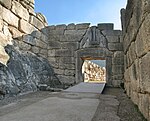
|
Peloponnese | 1999 | 941; i, ii, iii, iv, vi (cultural) | Mycenae and Tiryns were two of the most important cities of Mycenean Greece, which flourished between the 15th and 12th centuries BCE. The cities were palace economies with monumental architecture, such as the Lion's Gate and Treasury of Atreus. The Linear B tablets are the first testimonies of the Greek language. Both cities are linked to the Homeric epics Iliad and Odyssey, which have influenced the European literature and arts ever since.[18] |
| The Historic Centre (Chorá) with the Monastery of Saint-John the Theologian and the Cave of the Apocalypse on the Island of Pátmos | 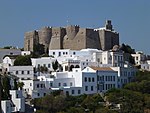
|
South Aegean | 1999 | 942; iii, iv, vi (cultural) | The Monastery of Saint-John the Theologian is dedicated to St John, who wrote both his Gospel and the Apocalypse on the island of Pátmos, according to Christian tradition. It was founded in the late 10th century and it has been a place of pilgrimage and Greek Orthodox learning ever since. The old settlement of Chorá, associated with the monastery, contains many religious and secular buildings.[19] |
| Old Town of Corfu | 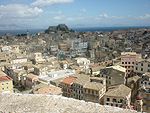
|
Ionian Islands | 2007 | 978; iv (cultural) | The roots of the Old Town of Corfu, on the eponymous island, date back to the 8th century BCE. Located at the entrance to the Adriatic Sea, the town was important in view of the defence of the maritime interests of the Republic of Venice against the Ottoman Empire. The Venetian engineers constructed three forts in the town. The Old Town buildings are mostly from the Venetian period and from the 19th century, when the island was a part of the British protectorate.[20] |
| Archaeological Site of Philippi | 
|
Eastern Macedonia and Thrace | 2016 | 1517; iii, iv (cultural) | Philippi was founded in 356 BCE by Philip II of Macedon. The city was a stop on the Via Egnatia and the site of the Battle of Philippi in 42 BCE. The Romans reshaped it into a "small Rome", adding public buildings including a Forum to Hellenistic ones. Following the visit of the Apostle Paul in 49–50 CE, the city became an early centre of the Christian faith, as demonstrated by the remains of Christian basilicas and an octagonal church.[21] |
Tentative list
[編集]In addition to the sites inscribed on the World Heritage list, member states can maintain a list of tentative sites that they may consider for nomination. Nominations for the World Heritage list are only accepted if the site has previously been listed on the tentative list.[22] 2021年現在[update], Greece had 14 such sites on its tentative list.[2]
| Site | Image | Location (region) | Year listed | UNESCO criteria | Description |
|---|---|---|---|---|---|
| Late Medieval Bastioned Fortifications in Greece | 
|
9 locations | 2014 | ii, iv, v (cultural) | The fortification system changed with the advent of gunpowder and thus more destructive means of warfare. Nine sites that are listed in this nomination represent examples of fortresses with bastions. They were built in the areas that often passed from the Venetian to Ottoman and other hands. The Old Town of Corfu is already a World Heritage Site. The fortress at Methoni is pictured.[23] |
| National Park of Dadia – Lefkimi – Souflion | 
|
Eastern Macedonia and Thrace | 2014 | x (natural) | This forest area in the Rhodope Mountains is home to many birds of prey, including three out of four European vultures: Egyptian vulture, Griffon vulture, and Cinereous vulture. It is also located at the important bird migration route for birds of the Western Palaearctic.[24] |
| Ancient Lavrion | 
|
Attica | 2014 | ii, iv (cultural) | Mining activities in the Lavrion area have been recorded since the 4th millennium BCE and continued well into the 20th century. During the Classical period, the silver from the mines helped to fund the construction projects in Athens and to build the navy. The site covers the remains of the mines and the associated industry, as well as sites in the ancient settlement of Thoricus and the Temple of Poseidon in Sounion.[25] |
| Petrified Forest of Lesvos | 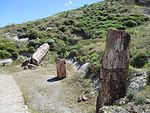
|
North Aegean | 2014 | vi, vii, viii, x (mixed) | The island of Lesbos was home to a mixed sub-tropical forest during the Early Miocene (18.5 million years ago, in the Burdigalian period). Due to volcanic eruptions that covered the area, plant remains have been preserved as fossils. The ares was explored by the philosophers Aristotle and Theophrastus, who then wrote a series of influential texts on ecology, biology, geology, and mineralogy.[26] |
| Archaeological site of Ancient Messene | 
|
Peloponnese | 2014 | i, iii, vi (cultural) | Messene is located in a fertile valley near the mountain Ithome. The first temples and shrines on the site date back to the 9th and 8th centuries BCE, while the city of Ancient Messene was founded in 369 BCE by the Theban general Epaminondas. The site is well-preserved as it has not been destroyed or covered by later settlements.[27] |
| Minoan Palatial Centres (Knossos, Phaistos, Malia, Zakros, Kydonia) | 
|
Crete | 2014 | ii, iii, vi (cultural) | The site covers the most important palatial centres of the Minoan civilization, which was a major Bronze Age power. The Minoans were exercising an enormous influence on cultures of the East Mediterranean and feature in a series of ancient myths, including those of Daedalus and Icaros and of the Labyrinth.[28] |
| Archaeological site of Nikopolis | 
|
Epirus | 2014 | ii, iv, vi (cultural) | The city of Nikopolis was founded by Augustus following the Battle of Actium in 31 BCE in the nearby area. It was a typical Roman colony city in Greek territory and was occupied until the 13th century. It was also an early centre of Christianity. Remains of monuments and public buildings have been preserved, as well as parts of a 50-キロメートル (31 mi) long aqueduct.[29] |
| The broader region of Mount Olympus | 
|
Thessaly, Central Macedonia | 2014 | vi, viii, ix, x (mixed) | Mount Olympus, the home of the Olympian gods, is the highest mountain in Greece, at 2,918メートル (9,573 ft). Many places of worship have been constructed on the mountain slopes, including the Chapel of the Prophet Elias at one of the peaks. The area is important in view of its mountain flora and fauna, as well as due to its geological features.[30] |
| The area of the Prespa Lakes: Megali and Mikri Prespa which includes Byzantines and post – Byzantine monuments | 
|
Western Macedonia | 2014 | ii, iv, vii, ix, x (mixed) | The area around the Prespa Lakes is rich in flora and fauna due to the habitat diversity, including wetlands, deciduous forests, and alpine meadows. The lakes are home to the largest breeding colony of Dalmatian pelicans, as well as several endemic plant and fish species. Many churches were built in the area in Byzantine and post-Byzantine times. Small Prespa Lake is pictured.[31] |
| Gorge of Samaria National Park | 
|
Crete | 2014 | vii, viii, ix, x (natural) | The Samaria gorge is one of the gorges in the Lefka Ori mountains in western Crete. The area offers diverse habitats, from mountains reaching above 2,000メートル (6,600 ft) to the coast, as well as several deep caves. These ecosystems are home to the Cretan goat and several endemic species, including the bearded vulture, Cretan wildcat, and the Mediterranean monk seal.[32] |
| Fortress of Spinalonga | 
|
Crete | 2014 | i, ii, iv, vi (cultural) | Spinalonga is a rocky islet off the northeastern coast of Crete. During the Venetian period, a fortress was built to protect the natural port of Elounda. The islet was taken by the Ottomans in the 18th century and it served as a leper colony in the first half of the 20th century.[33] |
| Ancient Towers of the Aegean Sea | 
|
North Aegean, South Aegean | 2014 | iii, iv (cultural) | This nomination comprises ten towers, built on the Aegean Islands and on the mainland, mostly in the 4th and 3rd centuries BCE. They were built in non-urban areas and served defensive purposes, sometimes as a part of wider fortification systems, as well as watchtowers and lighthouses. The White Tower at Serifos is pictured.[34] |
| Zagorochoria – North Pindos National Park | 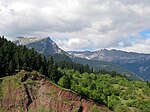
|
Epirus | 2014 | iii, v, ix, x (mixed) | The Pindus mountain range is home to a high number of animal and plant species, including brown bear, Eurasian otter, blue-throated keeled lizard, and Pindus stone loach in the Aoös river. People who live in this remote area belong to Sarakatsani, Aromanian Vlachs, and other groups. Their settlements feature traditional architecture.[35] |
| Ancient Greek Theatres | 
|
15 sites | 2014 | i, ii, iii, iv, v, vi (cultural) | This nomination lists 15 Greek theatres in different regions of Greece. Theatres were an indispensable element of urban centres from the Classical period onwards, attaining their full architectural form in the 4th century BCE. Some of the theatres in the nomination are parts of the existing World Heritage Sites: the Theatre of Epidaurus, the Theatre of Delphi, and the Theatre of Delos (pictured).[36] |
See also
[編集]References
[編集]- ^ “The World Heritage Convention”. UNESCO World Heritage Centre. 27 August 2016時点のオリジナルよりアーカイブ。21 September 2010閲覧。
- ^ a b c “Greece”. UNESCO World Heritage Centre. 18 September 2018時点のオリジナルよりアーカイブ。26 December 2020閲覧。
- ^ “UNESCO World Heritage Centre The Criteria for Selection”. UNESCO World Heritage Centre. 12 June 2016時点のオリジナルよりアーカイブ。17 August 2018閲覧。
- ^ “Temple of Apollo Epicurius at Bassae”. UNESCO World Heritage Centre. 18 November 2020時点のオリジナルよりアーカイブ。1 January 2021閲覧。
- ^ “Archeological site of Delphi”. UNESCO World Heritage Centre. 5 January 2021時点のオリジナルよりアーカイブ。1 January 2021閲覧。
- ^ “Acropolis, Athens”. UNESCO World Heritage Centre. 16 December 2020時点のオリジナルよりアーカイブ。1 January 2021閲覧。
- ^ “Mount Athos”. UNESCO World Heritage Centre. 15 January 2021時点のオリジナルよりアーカイブ。1 January 2021閲覧。
- ^ “Meteora”. UNESCO World Heritage Centre. 15 April 2020時点のオリジナルよりアーカイブ。1 January 2021閲覧。
- ^ “Paleochristian and Byzantine monuments of Thessaloniki”. UNESCO World Heritage Centre. 5 January 2021時点のオリジナルよりアーカイブ。1 January 2021閲覧。
- ^ “Sanctuary of Asklepios at Epidaurus”. UNESCO World Heritage Centre. 1 January 2021時点のオリジナルよりアーカイブ。1 January 2021閲覧。
- ^ “Medieval City of Rhodes”. UNESCO World Heritage Centre. 26 November 2020時点のオリジナルよりアーカイブ。1 January 2021閲覧。
- ^ “Archeological site of Mystras”. UNESCO World Heritage Centre. 5 January 2021時点のオリジナルよりアーカイブ。1 January 2021閲覧。
- ^ “Archeological site of Olympia”. UNESCO World Heritage Centre. 18 November 2020時点のオリジナルよりアーカイブ。1 January 2021閲覧。
- ^ “Delos”. UNESCO World Heritage Centre. 14 December 2020時点のオリジナルよりアーカイブ。1 January 2021閲覧。
- ^ “Monasteries of Daphni, Hosios Loukas and Nea Moni of Chios”. UNESCO World Heritage Centre. 17 November 2020時点のオリジナルよりアーカイブ。1 January 2021閲覧。
- ^ “Pythagoreion and Heraion of Samos”. UNESCO World Heritage Centre. 15 January 2021時点のオリジナルよりアーカイブ。1 January 2021閲覧。
- ^ “Archaeological Site of Aigai (modern name Vergina)”. UNESCO World Heritage Centre. 28 November 2020時点のオリジナルよりアーカイブ。1 January 2021閲覧。
- ^ “Archaeological Sites of Mycenae and Tiryns”. UNESCO World Heritage Centre. 16 May 2019時点のオリジナルよりアーカイブ。1 January 2021閲覧。
- ^ “The Historic Centre (Chorá) with the Monastery of Saint-John the Theologian and the Cave of the Apocalypse on the Island of Pátmos”. UNESCO World Heritage Centre. 14 December 2020時点のオリジナルよりアーカイブ。1 January 2021閲覧。
- ^ “Old Town of Corfu”. UNESCO World Heritage Centre. 19 November 2020時点のオリジナルよりアーカイブ。1 January 2021閲覧。
- ^ “Archaeological Site of Philippi”. UNESCO World Heritage Centre. 17 November 2020時点のオリジナルよりアーカイブ。1 January 2021閲覧。
- ^ “Tentative Lists”. UNESCO World Heritage Centre. 1 April 2016時点のオリジナルよりアーカイブ。 Template:Cite webの呼び出しエラー:引数 accessdate は必須です。
- ^ “Late Medieval Bastioned Fortifications in Greece”. UNESCO World Heritage Centre. 23 June 2020時点のオリジナルよりアーカイブ。31 December 2020閲覧。
- ^ “National Park of Dadia – Lefkimi – Souflion”. UNESCO World Heritage Centre. 23 June 2020時点のオリジナルよりアーカイブ。31 December 2020閲覧。
- ^ “Ancient Lavrion”. UNESCO World Heritage Centre. 15 January 2021時点のオリジナルよりアーカイブ。31 December 2020閲覧。
- ^ “Petrified Forest of Lesvos”. UNESCO World Heritage Centre. 21 October 2020時点のオリジナルよりアーカイブ。31 December 2020閲覧。
- ^ “Archaeological site of Ancient Messene”. UNESCO World Heritage Centre. 3 January 2021時点のオリジナルよりアーカイブ。31 December 2020閲覧。
- ^ “Minoan Palatial Centres (Knossos, Phaistos, Malia, Zakros, Kydonia)”. UNESCO World Heritage Centre. 19 September 2020時点のオリジナルよりアーカイブ。31 December 2020閲覧。
- ^ “Archaeological site of Nikopolis”. UNESCO World Heritage Centre. 29 September 2020時点のオリジナルよりアーカイブ。1 January 2021閲覧。
- ^ “The broader region of Mount Olympus”. UNESCO World Heritage Centre. 21 October 2020時点のオリジナルよりアーカイブ。1 January 2021閲覧。
- ^ “The Area of the Prespes Lakes: Megali and Mikri Prespa which includes Byzantine and post-Byzantine monuments”. UNESCO World Heritage Centre. 23 June 2020時点のオリジナルよりアーカイブ。1 January 2021閲覧。
- ^ “Gorge of Samaria National Park”. UNESCO World Heritage Centre. 4 August 2020時点のオリジナルよりアーカイブ。1 January 2021閲覧。
- ^ “Fortress of Spinalonga”. UNESCO World Heritage Centre. 1 January 2021時点のオリジナルよりアーカイブ。1 January 2021閲覧。
- ^ “Ancient Towers of the Aegean Sea”. UNESCO World Heritage Centre. 23 June 2020時点のオリジナルよりアーカイブ。1 January 2021閲覧。
- ^ “Zagorochoria – North Pindos National Park”. UNESCO World Heritage Centre. 17 September 2020時点のオリジナルよりアーカイブ。1 January 2021閲覧。
- ^ “Ancient Greek Theatres”. UNESCO World Heritage Centre. 25 November 2020時点のオリジナルよりアーカイブ。1 January 2021閲覧。
Template:World Heritage Sites in Greece
Template:Lists of World Heritage Sites in Europe

